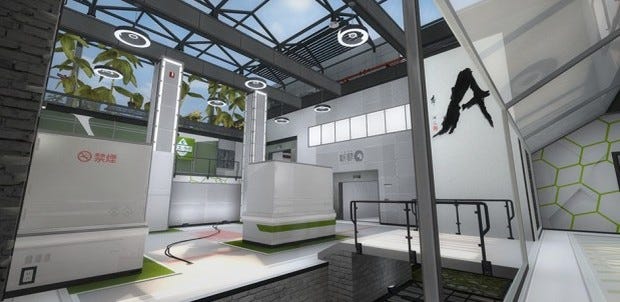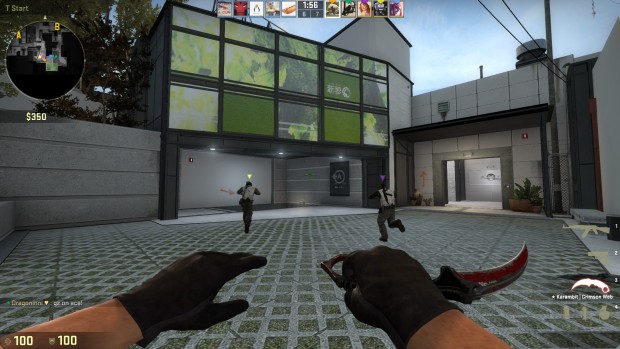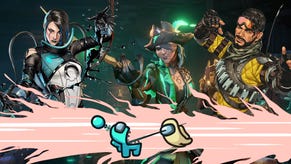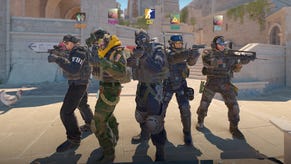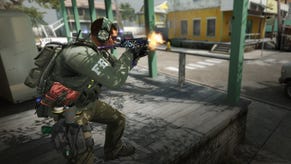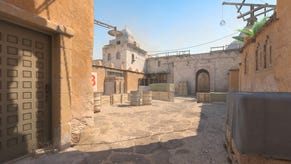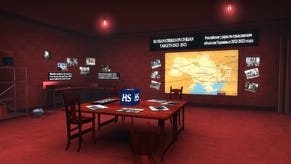How Do You Make A Professional Counter-Strike Map?
Pop Flash
In Pop Flash, a new series of insights into Counter-Strike: Global Offensive [official site], Emily Richardson looks past the amazing clutches, crushing defeats and humiliating knives in the face to understand the culture and meta of Valve’s everlasting competitive FPS. Why is it so popular? What the hell is that Scottish guy saying? And why can’t anyone resist opening those damn crates?
This week, I spoke to veteran level designer Shawn ‘FMPONE’ Snelling about map design in Counter-Strike and what it's like to construct levels for the most punishing and rewarding of FPS games. Having worked on the recent Cache and Season remakes, and some more famous maps besides, Shawn is known for his immaculate art style and well-balanced, flavourful levels.
At every major tournament, I see professional players playing the same maps in new and unexpected ways. It’s not always as overt as Fnatic standing on a previously unknown, invisible ledge to snipe LDLC down at Dreamhack Winter, but players continue to use terrain in ever fluctuating ways - a five-man bunny-hop to catwalk on Nuke or a cheeky boost on Dust2’s Short to shoot down Lower Dark. The game of Counter-Strike is one of nuance and delicacy, and in part, this is because of its maps.
As an FPS player, I find Counter-Strike’s level design some of the most compelling in any game. The balance is so precise that it’s a shame when poor map design comes along and wrecks it. Wall-clipping exploits, next-to-invisible sniper spots or a wildly imbalanced terrain advantage make me reeeaal grumpy. That’s why the classics, the maps that have ruled over 1.6, Source and Global Offensive, stand so tall. To make a good Counter-Strike map is to create something close to perfection, because it has to be that good to please discerning players.
The levels Shawn has remade follow some tried-and-tested formulas for good level design, and promote combat in an unusually balanced and engaging way. Three lanes divide the teams up nicely, giving the attackers plenty of options but never spreading the defending team too thin. An open, centre area offers a great place to kill or be killed fast, while connectors, boost-spots and sneaky corners offer versatility for special round-to-round tactics.
"Cache and Season are both fundamentally excellent Counter-Strike levels," Shawn explains, "Cache was originally created by Volcano, an ex-professional player, and Season by Ted, a veteran in the CS mapping world. There is a lot of heritage in those projects. It’s true that they’re both three-lane maps, without a lot of height variation. But what’s really great about both maps is that they have enough depth to remain interesting over many years, but are also relatively simple and easy to learn. The fact that both maps are 50-50 balanced in competitive gameplay doesn’t hurt either.
"In terms of their overall layouts, Cache, Season, Inferno, Mirage, and Dust2, are probably the most "traditionally designed" maps in Counter-Strike, because all five layouts place extraordinary emphasis on control of a central nexus area. As a player, I like that design motif a lot."
It’s a design motif that players in general seem to like, too. Dust2 is easily the most famous of Counter-Strike’s map repertoire, but Inferno, Mirage, Cache and now the revamped Season have all proved themselves to be big player favourites. With the exception of Season, which is still relatively new, these are also CS:GO’s professional tournament maps. But building levels like these must take tremendous effort and remaking old favourites must, in turn, create enormous pressure. How do you know when to make a big change to fan favourite in favour of modern functionality, and how does art design play a role in bringing a dated map back to life?
"My role on Cache and Season was to "remake" them, by combining my capabilities as an environment artist with my experience as a level designer," he explains. "Both levels have been part of Counter-Strike history since Source, but they lacked an artistic identity which set them apart. It was my job to first give the levels a unique and memorable theme with nice aesthetics, and then to tweak the designs for the "mainstream" without compromising their competitive spirit.
"My biggest struggle was probably during Cache. At one point, I thought I would have to abandon the project; it wasn’t going very well. But Volcano had faith in what we were doing, and we managed to push through some of the early struggles. That project and Volcano definitely taught me a lot of my most valuable lessons about competitive level design, including maintaining an upbeat atmosphere and keeping readability high.
"In terms of restructuring, there are a lot of examples on Cache especially where we changed some stuff around not so much for the art design, but more for improving the player experience. I like movement to be smooth and easy, a good example that flies under the radar these days is the decision to change Cache’s Upper B from a ladder into a ramp. There are plenty more examples, but I can’t imagine Cache any other way now."
This last thing resonates with me. I’ve always found verticality and height variation a threatening thing in CS. I’m not the world’s best player, and I’m not known for consistently landing the all-important instant headshots. When my enemy is on a ramp or a higher platform, I feel more vulnerable than in any other FPS, because I suck at adjusting the vertical axis for headshotting fast. Hopefully, everyone else does too. Controlling sniper spots and using the high ground is vital in CS:GO and I ask Shawn how he works with height variation in mind.
"Vertical gameplay is satisfying, but it’s also contextual. One thing I learned early on in CS:GO is that players don’t want to have to check too many angles at once, and vertical angles always end up being the highest priority threats because death from above comes so quickly. If you’re going to do vertical gameplay in CS:GO, it has to be pretty calculated and well designed. Catwalk on Dust2 is a great example of vertical gameplay, but compared to something like Q3DM6 it might as well be flat. Nuke is an example of a map where vertical gameplay contributed to balance issues, so it’s gone back to the drawing board. I’m excited to see what Valve cooks up there, because it’s going to be interesting and pretty educational. CS never really dives into verticality with enthusiasm, but like any other design constraint, a level designer could break it wide open if they understand the risks."
Speaking of breaking things wide open, Shawn’s ambitious art design is something that has elevated his two remakes - especially Season - away from the visual mundanity of many other maps. He’s broken away from the dusty-brown of Counter-Strike’s common sand-and-wood textures and made clean, bright levels with personality. Cache manages that brightness while still feeling like a strange, worn-out and abandoned part of old Chernobyl. Season’s white walls are so sterile and its steel so mechanical that the deep green plants seem more alive than the basil plant on my kitchen table. (I keep forgetting to feed it.)
We play the levels of Counter-Strike hundreds of times over, revisiting and reappraising them each time. I ask Shawn if aesthetics can help prevent the frustration of repetition and add depth of character, even a thematic story. I then wonder if such depth can get in the way of playability. Maybe simplicity is the backbone of good design?
"Details matter," he says. "That paint bucket I added to a level might seem trivial, and of course in the grand scheme of things it is, but I focus on the details because I want people to feel a visceral sense of quality when they play something I worked on. They might not care about that paint bucket, but they can tell I did and they know the lengths I went through to make them happy.
"I think it’s important that areas tell stories. What kind of story is less important because to some extent it’s better that the players fill in a lot of the blanks, but thematic details are really fun and contribute to the enjoyment of playing a level for as many hours as we often do.
"A good example for me is on the level Militia, in one part of the level there is an attic, with a solitary chair facing the attic’s one window. Leaning against the chair is an axe, and nearby is a bottle filled with God-knows what. Details like that stick with me as a player, they’re as fascinating and symbolic as they are simple. In terms of how to prevent details like these from interfering with the player experience, that one is pretty easy: ask the players. If they’re annoyed, it’s a fail."
I think more about maps and their stories, and I’m reminded of how weird Agency is to me. It’s a map that has an advertising building sitting on the roof of a skyscraper, with a helipad right outside the front door. The edge of the skyscraper isn’t even fenced off - surely fictional employees will fall to their deaths after a few drinks at the Christmas party? How does a level designer make these environments believable? Does it even matter if they do?
"I think that’s a bit more subjective," Shawn says. "There are going to be things that levels do that violate basic principles of reality. We sort of accept them as long as the level designer is clever enough. You never want players to hyper-focus on the fact that they’re playing a video game level, so at the end of the day it’s all about managing suspension of disbelief. Agency suspends my disbelief by being ridiculously gorgeous, which is always a good tactic!"
So how does it feel for Shawn to see professionals play his levels for huge cash prizes? Does he feel the pressure? Is it intimidating, trying to create enough flavour and texture to keep general players interested, but streamlined enough for the pros to play on?
"There is immense pressure in designing a map for CS:GO," he said. "Everyone’s default state is that they don’t care, the map won’t succeed. It’s my job as a level designer to make work which is of a high enough quality that people start asking all kinds of questions, such as ‘is this going to go Active Duty? Maybe it ought to…’ That’s always my goal. When I work on a competitive level, I envision professional players playing it, and I try to meet that very high standard. Certain things are sacred for me: don’t annoy players. If something can be smoother, easier or better, it should be. Every specific design quandary you face can open a can of worms, so it’s never as easy as just being smart and brilliant and pressing the ‘make it good’ button. It takes a lot of thought to make the player experience seamless, and that’s on top of all the expected and unavoidable hard work.
"In terms of how does it feel to watch teams like Fnatic, TSM, EnvyUs, Cloud9, it’s always a treat no matter what level they’re playing. But when it’s a level I worked on that’s pretty cool too. I don’t want to say I’m ‘over it’, because I’m so not, but one thing that happens is I don’t feel that I own these levels. These levels belong to all of us - what I love about mapping is that we get to enjoy the maps together."
That said, what advice would Shawn give to people wanting to get into level design - especially for Counter-Strike? What past experiences have led him to this point in his career?
"I’ve been creating levels since I was a little kid," he says. "It’s something I’ve always wanted to do ever since the days of drawing Mega Man 2 levels on grid paper. I actually released my first level when I was about 16, for Day of Defeat: Source. I received a tremendous sense of accomplishment and achievement from playing something I created with other players, and ever since then I’ve been hooked. I worked on some levels for Natural Selection 2, and I’ve released five CS:GO levels. Even after five levels, mapping for CS:GO hasn’t stopped being interesting and challenging for me, there’s still so much to learn."
Shawn is currently working on his sixth Counter-Strike map, Santorini, which is set in Greece. "My goal with Santorini is to deliver a solid competitive layout with high visibility and a well-realised theme," he tells me. Having played his previous maps, I’m excited to see what Shawn can do with the popular Greek island.
"In terms of advice, it’s always the same: become a student of level design. Don’t merely play levels, walk around them and learn from every specific decision the level designer made. Every piece of geometry, every texture, every light, every dimension of every area, all these elements represent conscious decisions worth exploring, critiquing, and understanding. The best levels are full works of art where every creative decision was thoughtful and intelligent. Those sorts of levels inspire the hell out of me."
I have just one final question for Shawn: is it sneaky beaky or sneaky peeky?
"It’s sneaky beaky like," he says. "Definitely."
